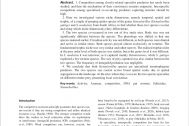Obsah
- Competition among closely-related specialist predators has rarely been studied, and thus the mechanism of their coexistence remains enigmatic. Interspecific competition among specialised co-occurring predators capturing termites should be high.
- Here we investigated various niche dimensions, namely temporal, spatial and trophic, of a couple of jumping spider species of the genus Stenaelurillus (Stenaelurillus guttiger and S. modestus) from South Africa, to find whether these two species co-exist and along which niche dimension(s) they differentiate.
- The two species co-occurred in two out of five study sites. Body size was not significantly different between the species. The phenology was shifted so that one species matured earlier. Circadian activity was not different, as both species were diurnal and active at similar times. Both species preyed almost exclusively on termites. The fundamental trophic niche was very similar and rather narrow. The realised trophic niche at the prey order level of both species was similar, but at the genus level it was different. In S. modestus it was narrower, as it captured mainly Odontotermes, while S. guttiger exploited a few termite species. The size of prey captured was also similar between the two species. The frequency of intraguild predation was negligible.
- We conclude that both Stenaelurillus species are specialised termitophagous predators. The two species can coexist across broad spatial scales due to spatial segregation on the landscape. At the sites where they co-occur, the two species specialise on different termite prey, promoting local coexistence.



